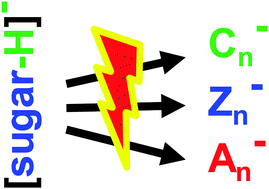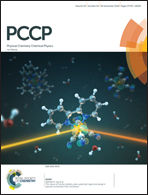Deprotonated carbohydrate anion fragmentation chemistry: structural evidence from tandem mass spectrometry, infra-red spectroscopy, and theory†
Abstract
We investigate the gas-phase structures and fragmentation chemistry of deprotonated carbohydrate anions using combined tandem mass spectrometry, infrared spectroscopy, regioselective labelling, and theory. Our model system is deprotonated, [lactose-H]−. We computationally characterize the rate-determining barriers to glycosidic bond (C1–Z1 reactions) and cross-ring cleavages, and compare these predictions to our tandem mass spectrometric and infrared spectroscopy data. The glycosidic bond cleavage product data support complex mixtures of anion structures in both the C1 and Z1 anion populations. The specific nature of these distributions is predicted to be directly affected by the nature of the anomeric configuration of the precursor anion and the distribution of energies imparted. i.e., Z1 anions produced from the β-glucose anomeric form have a differing distribution of product ion structures than do those from the α-glucose anomeric form. The most readily formed Z1 anions ([1,4-anhydroglucose-H]− structures) are produced from the β-glucose anomers, and do not ring-open and isomerize as the hemiacetal group is no longer present. In contrast the [3,4-anhydroglucose-H]−, Z1 anion structures, which are most readily produced from α-glucose forms, can ring-open through very low barriers (<25 kJ mol−1) to form energetically and entropically favorable aldehyde isomers assigned with a carbonyl stretch at ∼1640 cm−1. Barriers to interconversion of the pyranose [β-galactose-H]−, C1 anions to ring-open forms were larger, but still modest (≥51 kJ mol−1) consistent with evidence of the presence of both forms in the infrared spectrum. For the cross-ring cleavage 0,2A2 anions, ring-opening at the glucose hemiacetal of [lactose-H]− is rate-limiting (>180 (α-), >197 kJ mol−1 (β-anomers)). This finding offers an explanation for the low abundance of these product anions in our tandem mass spectra.



 Please wait while we load your content...
Please wait while we load your content...